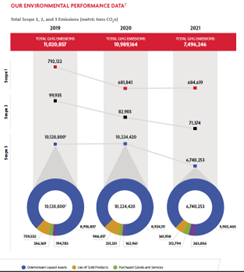Ryder corporation has released its Corporate Sustainability Report for
last 2021. They seem to be making more progress than many organizations,
especially in the transportation industry. But their environment is one of the hardest
to move to zero emissions. Long-haul trucking will be around for a long time
and switching from diesel is difficult. All of the reporting creates fodder for
anyone on the left, right or center to hammer on endlessly. See the Ryder Corporate Sustainability Report here: https://www.ryder.com/about-us/sustainability
To match with the more recent terms and reporting
approaches, Ryder refers throughout the CSR as Environmental, Social and
Governance (ESG). A 3rd party is helping with the ESG reporting. The graphic from page 13 in the CSR report shows only a fraction of emissions from Scope 2 and Scope 3. (Scope 1 is completely with an organizations control.)
Ryder ships stuff for other people, directly and indirectly.
Who should be counting up all the carbon costs? If there were no parts shipped
in the auto industry, there would be no trucks moved and zero carbon costs. Same
with service and repairs. And, of course, the huge part of the equation is
leased vehicles to other businesses that ship using Ryder-owned vehicles. (If 95% of emissions are within the domain of the businesses who use the trucks for shipping, this is where the massive amount of emission are. In other circumstances that might fall within Scope 3 for Ryder, but it seems that Ryder is not taking responsibility for the shipping that other businesses do. Rightly so. Just so long as someone takes responsibility for all the shipping, everywhere.)
Ryder has specific, measurable and attainable targets for
several things. The emissions from their facilities. Energy efficiency in the
buildings is set to be down 30% for 2018 to 2024. The nice thing about that is
it saves money, especially with energy (electric) costs going up (rapidly)
every year. They have targets and training for drivers to drive better and safer.
(Less accidents save massive amounts of money.)
At first look it seems that Ryder is not doing well on this safe-driving metric, but the situation is probably
much more complicated, likely because of pandemic and supply shortages for 2+ years.
Especially for short-haul, Ryder has been working on
alternatives for decades, with lots of early work on moving trucks to natural
gas. (Cleaner, but still a fossil fuel.) The same concepts that work for NatGas
work for hydrogen (if H2 ever makes it to full viability). As with electric
trucks, the infrastructure is needed before you can use the alternative fuel
vehicles.
So, some things sustainability-wise – like efficiencies –
are great business decisions all around. Building and fuel efficiencies same
money now and offer a perpetuity of savings forever (if maintained). Wind skirts on trailers improve fuel efficiency from 8 to 9 mpg. Oh, and
efficiencies are good for the environment, too.
Other things are much more complicated and require much more
lead time and staged investment. Switching to alternative fuels, requires the
infrastructure first, or at least part of the infrastructure. Also, the new
technologies require additional/different training for service and maintenance.
Note that Ryder is training 10% of technicians on alternative fuel technologies
(each year).
Ryder is moving past the chicken-and-egg problem. Measure
first. Then move into the Plan-Do-Check-Act process of sustainability. The low-lying
fruit should come first, then move into the initiatives that will really make a
difference.
#SustainabilityReporting, #ScopeEmissions, #ESG, #CSR, #Transportation, #SupplyChain

